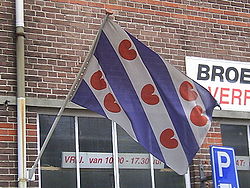
Frisian Flag
Encyclopedia

Friesland
Friesland is a province in the north of the Netherlands and part of the ancient region of Frisia.Until the end of 1996, the province bore Friesland as its official name. In 1997 this Dutch name lost its official status to the Frisian Fryslân...
.
It consists of four blue and three white diagonal stripes; in the white stripes are a total of seven red pompeblêden, stylised heart-shaped leaves of yellow water-lily
Nuphar lutea
Nuphar lutea is an aquatic plant of the family Nymphaeaceae, native to temperate regions of Europe, northwest Africa, and western Asia.-Growth:...
. The jerseys of the football club sc Heerenveen and the Blauhúster Dakkapel are modeled after this flag.
Symbolism
The seven red pompeblêden are a reference to the Frisian "sea countries" in the Middle AgesMiddle Ages
The Middle Ages is a periodization of European history from the 5th century to the 15th century. The Middle Ages follows the fall of the Western Roman Empire in 476 and precedes the Early Modern Era. It is the middle period of a three-period division of Western history: Classic, Medieval and Modern...
: independent regions along the coast from Alkmaar
Alkmaar
Alkmaar is a municipality and a city in the Netherlands, in the province of Noord Holland. Alkmaar is well known for its traditional cheese market. For tourists, it is a popular cultural destination.-History:...
to the Weser who were allied against the Vikings. There were never precisely seven distinct rulers, but the number seven probably has the connotation "many." Some sources hold, however, that there have been seven Frisian lands: West Friesland
West Friesland (historical region)
West Friesland is a historical region in the northern part of the Netherlands. It was located in parts of what now is Noord-Holland and the Waddenzee. The region was bordered by the rivers Vlie and IJ...
, Westergoa
Westergoa
Westergoa was one of the seven sealands and one of the three that now lie within the borders of today's Dutch province of Friesland. Later it was one of the three goaen of Frisia. In the Middle Ages Westergoa most probably formed the political centre of the Frisian realm.- Area :On the eastern...
, Eastergoa
Eastergoa
Eastergoa was one of the seven areas and one of the three gaue that lay within the borders of the today's Frisian province of Friesland in The Netherlands.- Area :...
, Hunsingo, Fivelingo, Emsingo, and Jeverland
Jeverland
Jeverland refers to the northern part of the present-day district of Friesland in northern Germany with the town of Jever as the seat of its local government. The Jeverland was formed in the 15th century from the Barony of Jever, which itself descended from the Banter Viertel, part of Östringen...
.
The pompeblêden are used in other related flags such as the flag of the Ommelanden
Ommelanden
The Ommelanden are the parts of Groningen province that surround Groningen city. Usually mentioned as synonym for the province in the expression Stad en Ommeland ....
in neighbouring Groningen Province
Groningen (province)
Groningen [] is the northeasternmost province of the Netherlands. In the east it borders the German state of Niedersachsen , in the south Drenthe, in the west Friesland and in the north the Wadden Sea...
, a historically Frisian area, and for a proposed pan-Frisia
Frisia
Frisia is a coastal region along the southeastern corner of the North Sea, i.e. the German Bight. Frisia is the traditional homeland of the Frisians, a Germanic people who speak Frisian, a language group closely related to the English language...
flag put forth by the Groep fan Auwerk
Groep fan auwerk
The Groep fan Auwerk is an organisation that struggles for an independent Greater Frisia. The land that covers the Greater Frisia region, according the Groep fan Auwerk , comprises four parts as expressed in the Pan-Frisian flag advocated by the group:...
.
History

Kudrun
Kudrun , is a Middle High German epic, written probably in the early years of the 13th century, not long after the Nibelungenlied, the influence of which may be traced upon it....
. Round 1200 Scandinavia
Scandinavia
Scandinavia is a cultural, historical and ethno-linguistic region in northern Europe that includes the three kingdoms of Denmark, Norway and Sweden, characterized by their common ethno-cultural heritage and language. Modern Norway and Sweden proper are situated on the Scandinavian Peninsula,...
n coats of arms
Coat of arms
A coat of arms is a unique heraldic design on a shield or escutcheon or on a surcoat or tabard used to cover and protect armour and to identify the wearer. Thus the term is often stated as "coat-armour", because it was anciently displayed on the front of a coat of cloth...
reveal many traces of water-lilies and hearts, found often in combination with images of lion
Lion
The lion is one of the four big cats in the genus Panthera, and a member of the family Felidae. With some males exceeding 250 kg in weight, it is the second-largest living cat after the tiger...
s.
15th century books on heraldry
Heraldry
Heraldry is the profession, study, or art of creating, granting, and blazoning arms and ruling on questions of rank or protocol, as exercised by an officer of arms. Heraldry comes from Anglo-Norman herald, from the Germanic compound harja-waldaz, "army commander"...
show that two armorial bearings were derived from the early ones: a coat of arms showing lions and seven pompeblêdden transformed into little blocks, the other being the arms with the seven now known lilies on stripes.

